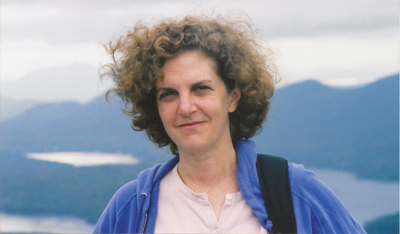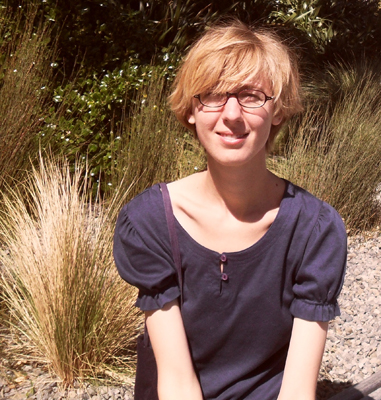Interviews
Turning out One's Pockets:
Carolina Skibinski in Conversation with Anne Marie Todkill

Anne Marie Todkill talks with Malahat volunteer Carolina Skibinski about "Hoarding" (#177, Winter 2011), winner of our 2011 Constance Rooke Creative Nonfiction Prize.
Terry Glavin, the judge for this year’s nonfiction competition, described the language in your winning piece as “plain and everyday,” and from this, “the wholly unglamorous people and even the tiniest of objects are allowed to tell their embellished and extraordinary stories.” It is interesting to me that in using a crisp and lucid style you seem to reveal an inextricable relationship between that which is hidden and uncovered; for instance you remark, “To recover a history, one must first bury it.” I would like to know your thoughts on the language you used and whether you intended it to relate to the secrets and hiding places, and uncovering and untangling, in your piece.
You might think this is odd, but I was surprised by Terry Glavin’s description—which I am deeply grateful for, by the way—of my “perfectly ordinary lexicon.” In other contexts, I would say, a plain vocabulary has not been my trademark. But then I realized that perhaps I’d succeeded in doing something I’ve been trying to do for some time. I think I suffered from an overexposure to Virginia Woolf at an impressionable age, not to mention my gluttonous consumption of Victorian novels over a period of time, and so the plain phrase was not what I’d been schooled in, so to speak. That being said, I don’t think I was making the sophisticated calculation that you suggest when I pitched the language of this piece the way I did. I just wanted to be blunt. And I wanted to be precise. I worried that those “tiny objects” would be of no interest to the reader. So I did what I do as an editor, which is to strip the sentences down. Most writing improves—at least to the contemporary ear—when you take words out.
When you allowed me, as a reader, to view the contents of your brother’s pockets, the “pins, broken fasteners, key chains ...” he collected, I felt like a trespasser. You wrote that he would never let you “inspect” his pockets “without sparking a conflict” and you showed a glimpse of what such a conflict would involve. Since this is a creative nonfiction piece, and turns out your own pockets, as it were, I was wondering whether you wrote with hesitation.
What a great metaphor for writing: turning out one’s pockets. I certainly have less hesitation about turning out my own pockets in public than turning out my brother’s, as a matter of fairness among other things. And here art follows life—there is an inherent intrusiveness in providing care for those who cannot care for themselves independently; this is one of the fundamental difficulties, on both sides, of this kind of relationship. I think these difficulties are important to examine candidly, like any other aspect of life. But, to go back to your question, and at the risk of being pedantic, I didn’t hesitate to write so much as to be published. In the process of writing, all I was concerned with was achieving a certain degree of precision, and a certain degree of honesty. These two things are, of course, related; honesty can arise from specificity. My immediate concern was with getting the text to match the emotion—without masking it, but without getting bogged down, either. As for the trespass—frankly, I thought that problem would be taken care of for me when the manuscript bombed. I didn’t expect this reception at all. But, once it became clear that the piece had struck a chord somehow, I had to think again about whether the trespass was warranted. I hope it is. I hope this piece is useful as one little drop in the great therapeutic bucket of family narratives out there. Besides, in a sense, once a personal story is published it isn’t personal any more. It becomes whatever the reader makes of it, and the actual people in it are really not so important. They are abstracted, selective representations and will be reconstructed by each reader differently. Not that this kind of reasoning would let me off the hook for doing any harm.
Did you set out to write a type of eulogy? When did the story take definite shape and style in your mind? Did this piece involve much rewriting?
Answering the “when” question would involve sifting through a humbling archive of false starts; I’d rather spend the time cleaning the fridge or something. Rewriting? You bet. Although less than with some pieces, it seems to me. As for the eulogy—well. This piece dealt me a bit of a sucker-punch when I realized what the sewing machine was all about—however obvious it seems now, it wasn’t so clear to me at the start.
“The meaning we ascribe to a maddening behaviour might not be correct. Its value, regardless, is to help us be more tolerant.”
This is one of my favorite excerpts from your story. When I read I often wonder about how a text asks to be interpreted, and here, although you are not directly referring to writing, it seems that you are giving the reader free rein. Did you intend your work to be accepting of multiple interpretations?
I don’t think I had textual interpretation in mind at all when I wrote this, although it’s true that the reader is free to decide what construction of things to accept—or, perhaps, what alternative to put forward, whether in this particular narrative or with someone in his or her own life who is similarly difficult to “interpret.” For myself, I can only claim a kind of agnosticism about my brother’s inner life. I would confess, though, to a personal frustration with the platitudes of psychology on the one hand and biochemical explanations on the other as ways to account for the human psyche. Both approaches are reductive, however well-intentioned they may be. People are mysterious. Fortunately for writers, the process of interpretation is endless.
I heard that you are working on a longer nonfiction piece. Are there any ways in which you treat your fiction and nonfiction projects differently?
I think the process is quite similar—both forms involve dredging the swamp. With a nonfiction piece of the memoir type, one is trawling for memories, but also taking a risk in trying to face whatever it is that snagged them on the net in the first place, or why one memory gets tangled with another. In writing fiction, the same thing applies, although with the added liberty—and challenge—of making stuff up. That is, in writing fiction I go through the same process of interrogation. What is this detail really about? Why did it turn up? Where does it fit? In both forms there’s the same angst about whether the voice is “authentic,” whether the pace and rhythm are right, whether the through-line works and the language is fresh—all the usual preoccupations.
Where should your readers look for previous and new publications of your work?
Well, there isn’t much. I’ve published a couple of short stories and a poem in Ars Medica, a journal of the medical humanities published in Toronto. One story has been anthologized by the University of Toronto Press, as a matter of fact. I published a couple of poems in The Malahat Review in 2011 (issue #174, Spring 2011). And a poem in Arc. I’ve reviewed fiction for LRC and the Women’s Review of Books. In a former life with the Canadian Medical Association Journal I published quite a few art and book reviews, commentaries, editorials, and so forth. As for new publications—I’m working on a handful of projects but have no hatchlings to announce just now. I’m leery of talking about work in progress. It’s the best way I know of to run aground.

Carolina Skibinski
* * * * * * * *
Check out the guidelines for our 2012 Constance Rooke Creative Nonfiction Prize.









